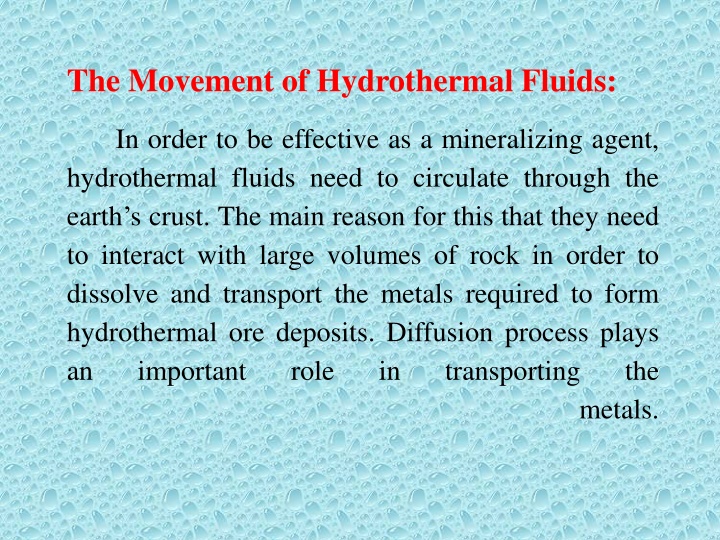
Hydrothermal Fluid Movement in Earth's Crust
Exploring the movement of hydrothermal fluids in the Earth's crust is essential for mineralization. Factors affecting fluid flow at a crustal scale, such as original and induced openings in rocks, play a significant role in the transport of metals to form ore deposits.
Download Presentation

Please find below an Image/Link to download the presentation.
The content on the website is provided AS IS for your information and personal use only. It may not be sold, licensed, or shared on other websites without obtaining consent from the author. If you encounter any issues during the download, it is possible that the publisher has removed the file from their server.
You are allowed to download the files provided on this website for personal or commercial use, subject to the condition that they are used lawfully. All files are the property of their respective owners.
The content on the website is provided AS IS for your information and personal use only. It may not be sold, licensed, or shared on other websites without obtaining consent from the author.
E N D
Presentation Transcript
The Movement of Hydrothermal Fluids: In order to be effective as a mineralizing agent, hydrothermal fluids need to circulate through the earth s crust. The main reason for this that they need to interact with large volumes of rock in order to dissolve and transport the metals required to form hydrothermal ore deposits. Diffusion process plays an important role in transporting the metals.
How large volumes of fluid can move around at deep levels in the earth s crust, where rocks are highly compacted and have low permeability? Movement of fluid is a response to either a thermal or a pressure gradient in the earth s crust related to deformation: *At shallow crustal depth, fluid flow occurs in response to a gravity-driven hydraulic head. * Large-scale flow of fluid at a crustal scale can also occur]in association with the dilatancy (i.e. change in volume) of a rock mass that accompanies faulting and seismic rupture. * In oceanic crust fluids flow in response to thermal gradient formed because of the high heat flow that characterizes the midocean ridges.
Factors affecting fluid flow at a crustal scale: The movement of hydrothermal solutions from source to site of deposition is dependent upon available opening in the rocks. These opining serve as both channel ways to the hydrothermal fluids and as a site for the deposition of the ore. These opening can be classify into following: (A) Original Openings(Primary): 1- Pore space 2- Crystal lattice 3- Vesicles holes 4- Lava drain channel 5- Cooling cracks 6- Igneous breccia cavities 7-Bedding plane
(B) Induced openings (Secondary):- 1- Fissures 2- Shear zone cavities 3- Cavities of folding and warping (Saddle reefs opening, pitches and flats) 4- Volcanic pipes 5- Tectonic breccia 6- Solution caves 7- Rock alteration opening
